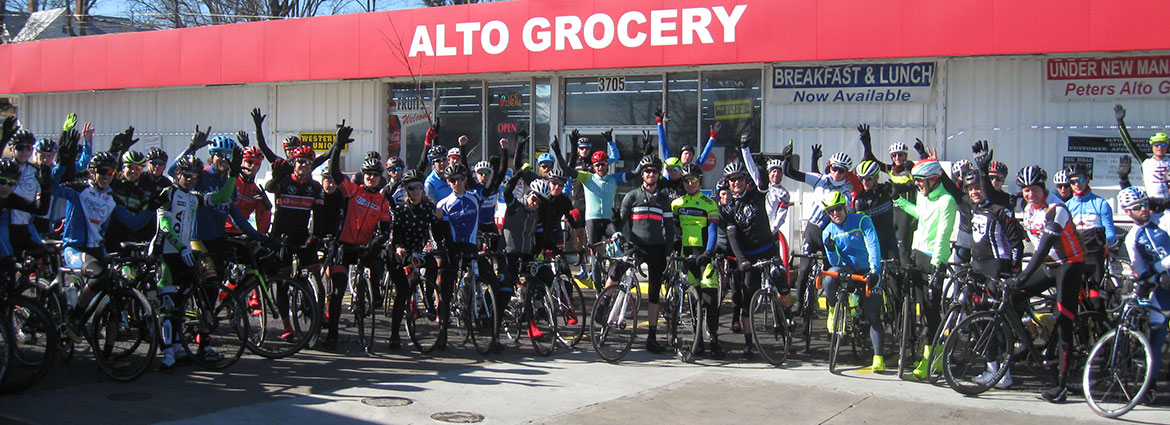Bad Dog!
Bad Dog!
“Bad dogs” and “bad legs” are the bane of every cyclist’s existence. In this critical summary, however, I will leave off discussing bad legs for another day and focus my gaze only upon dogs, specifically the bad ones. After all, an analysis of bad legs would force me to delve into the murky waters of a road cyclist’s mind and attempt to explain why pedaling with two heavy appendages will plunge a cyclist into a deep, dark and depressive stupor, a serious subject matter far outside the parameters of our comical foray.
In the world of road cycling, there are either “good dogs” or “bad dogs.” There is no in-between. In life, there usually are not such clean lines of separation. Instead, there are gray, dusky regions where one point or position dissolves into another. For example, take human beings. Humans are a baffling blend of both benevolent and malignant traits. This fusion of opposites creates a curious dualism that can make one act like an Apostle at certain times and a complete Asshole at others. Since the dawn of critical thinking, a vast army of philosophers and have spilled oceans of ink in an attempt to reconcile these antipodal traits. However, when it comes to dogs, there is no comingling of opposites. Dogs are either “good” or “bad” and the line separating the two types is big, bright and bold, like Ru Paul strutting down the runway dressed like a drag queen.
The categorization of a dog is simple: A “bad” dog is one that will crash a rider and a “good” dog is one that won’t. This short piece is intended to help a cyclist (you) identify certain characteristics that are common to each category, and to highlight the best avenues of escape in case of emergency. This brief summary may one day save your life, and unlike Linnaean taxonomy, one need not be a scholar to comprehend the classification system advanced in this précis. Instead, understanding is based solely on the ability to feel fear.
The Brute: The Brute is the paragon of all bad dogs. The Brute has massive jaws, Herculean strength and thick muscles that bunch up on its back when it’s lying down. The Brute usually has slobber oozing from both sides its mouth in long, sticky threads. Oftentimes, the Brute can be found lazing under a large shade tree contentedly crunching the femur bone of a former cyclist who pedaled too slowly when circumstances called for speed. The Brute typically usually uses its colossal head as a battering ram to knock a cyclist to the ground. Thereafter, the Brute will rip the rider to ribbons with its teeth, saving the femur bone for a later treat. Once it has finishing devouring the unlucky cyclist, the Brute carries the femur bone off and buries it beneath a nearby shade tree. The Brute can be found for the next few days lounging beneath the tree and periodically munching on the femur bone.
The Brute is built for speed and its modus operandi is the swift assault. In other words, the Brute is the Reinhold Messner of bad dogs, which means it is actually a bad ass dog. When the Brute spots a cyclist, or simply hears the whirrrrr of an approaching cyclist’s wheels, its ears leap to attention and its head jerks up like it’s been shot through with a thousand volts of cosmic sizzle. In less than a whisker-flash the Brute is sprinting full tilt towards the intended victim. When the Brute sprints, it stays low to the ground like a fired missile. Its sheer power and strength are obvious by the large swatches of real estate it covers with every bound. The Brute begets sheer terror in its intended target. The best option for a cyclist is to never cross the path of the Brute, but if you ever look up and realize that a Brute is zeroing in on you, pedal like a lunatic just let loose from the Funny Farm. And pray. Yes, pray that one of your comrades is slower than you, or else it might your femur bone that is soon buried beneath the big shade tree.
The Beast: The Brute and the Beast are two wholly different creatures, though genetic markers in their DNA sequence indicate that there is certainly some slack-jawed killer—a mitochondrial Eve—common to each’s ancestral woodpile. Though they are both “bad dogs,” the Brute’s status is based on pure power and raw speed while the Beast’s position of prominence in the hierarchy of bad dogs is based on bulk. The Beast is big but not necessarily fast, and the Brute is fast but not always big. Both, however, possess unrivaled strength and an ingrained inkling to kill. Though both live for nothing other than to feast on the flesh and bones of a cyclist, due to their disparate physical attributes, each must achieve its goal by distinct and entirely divergent tactics.
Instead of chasing down a cyclist with a rapid burst of speed, the Beast simply impedes a rider’s progress by blocking the road with its body. The Beast, because of its massive size and stature, can seal off an entire lane by simple standing sideways in the road. And if a car is approaching in the opposite direction, effectively blocking the only avenue of escape, a rider will usually run headlong into the flank of the oversized dog and catapult forward head-over-heels. Once a rider is on the ground, the Beast, like its cousin the Brute, will surely feast. The best defense for a rider who rides up on a Beast blocking the road is to make sure to have a fat friend along for the ride—the Beast will be attracted to your fleshy friend first. While the Beast is chomping on your friend, pick yourself off the pave and head for the hills as fast as you can. Once home, keep your mouth shut about your former friend’s misfortune and no one will ever be the wiser. And whatever you do, don’t look back while you run away—hearing the horrible, blood curdling screams will be bad enough.
The Tail Wagger: The Tail Wagger, contrary to popular myth, is a “bad dog” extraordinaire because it is capable of causing massive carnage. The mental capacity of the Tail Wagger is near the bottom of the intelligence chart, hovering around the “Not a F------ Clue” range, which means this type of dog is actually more dangerous than either the Brute or the Beast. The Bible teaches that the devil wears many disguises and the Tail Wagger, along with the Trinity Broadcasting Network’s big-haired carnival barkers, is positive proof. Off the bike, the Tail Wagger is affectionate and friendly and craves nothing but love and adoration. A Tail Wagger is a steadfast and faithful friend, a point of pride among the dogs’ owners. Unfortunately, this trait only exaggerates the Tail Wagger’s multiple deficiencies. The Tail Wagger has survived for generations not because it is a cunning artful dodger, but simply because it is a dumb dog that has been coddled. Tail Waggers have matured in the lambent light of their owners’ all-encompassing adoration, and naturally the dogs assumes that all humans are vessels of love. The Tail Wagger is similar to many people with no clue that another perspective other than their own exists—the doors of perception have been painted black. And as the famous soliloquist said, “Ay, there’s the rub.”
When a Tail Wagger spots a pack of cyclists ripping down the road, it jumps up, and with its tail wagging and hips swinging and tongue hanging out, trots toward the oncoming mass oblivious to the obvious. The Tail Wagger feels nothing but the warm hum of affection for the approaching cataclysm. The Tail Wagger assumes that the dozen or so humans fast approaching will surely stop and stroke its head and chin and whisper sweet tidings of comfort and joy. Thus, a Tail Wagger will trot straight into the moving swarm of riders. The Beast and the Brute will hone in on only one unlucky soul, but the Tail Wagger is famous for wiping out a dozen or more riders at a time. If you ever find yourself trapped in a fast-moving pack bearing down on an approaching Tail Wagger, the best advice is to grip your bars, close your eyes, and whisper, May the force be with me, and hope for the best. If you here metal scraping and bikes clanging off the pavement behind you, open your eyes, shift to a bigger gear, and ATTACK! The victory is yours!
The King of the Road: The King of the Road is the elder statesman in the world of dogs and exists in highest stratum of the canine hierarchy. The King of the Road is a “good dog” par excellence. The reason the King of the Road is such a respected sage in the hood is because in fact it does own the whole damn road. The King of the Road proves its point repeatedly by laying down in the middle of the road and refusing to budge. However, even though the King of the Road owns the road, it demands no tariff, no taxes and no tribute. “Live and let live” is its creed. The King of the Road has lived long enough to realize the absolute stupidity of chasing after anything, including lady dogs, much less cars and bikes. The King of the Road has developed a Buddha-like demeanor and nothing can disrupt its even-keeled equanimity. The King of the Road is a bodhisattva in the kingdom of canines, and like the Pope, engenders respect in others by its overwhelming aura.
The King of the Road is categorized by size as well as its calm and tranquil demeanor. On a sunny day, the King of the Road will amble outside and plop down in the middle of the road, usually directly in front of its home. Once down on the warm pavement, the King of the Road will not budge, even if a tank comes rumbling down the street, much less a pack of shaved-legged dandies riding expensive bikes and yapping about their latest Strava conquest. At most, the King of the Road will raise its head at a passing person, but not always. Sometimes the King of the Road will only open one eye and shut it quickly. The King of the Road poses no danger to passing cyclists as long as they proceed with due care as they pass. The King of the Road is a gentle giant. Just don’t ride over its tail.
The Ankle Biter: The Ankle Biter is the holy terror of bad dogs. The Ankle Biter is a small-legged, speed freak with a nasty temperament. It’s a vicious little bitch too boot. The Ankle Biter sends waves of panic surging through an intended victim when he or she realizes an assault is underway. Sometimes when realization occurs, it’s already too late. The Ankle Biter has learned that because it is a miniature assassin, its most effective strategy is to attack a cyclist from the rear and try and tear bits of flesh from the back of his or her ankles, which often causes the cyclist to crash. When the cyclist falls into a semi-conscious stupor from either landing on his or her noggin, or from a large loss of blood from the bleeding ankle wound, the Ankle Biter moves in and finishes the job. The Ankle Biter is a crafty, back alley cutthroat, and because it has honed its skill to a blue-tipped flame, its success rate, which is based on the number of “kills” it averages in a typical season, rivals that of both the Beast and the Brute.
The Ankle Biter uses quickness, stealth and deadly cunning when launching an attack. When an unsuspecting cyclist comes gliding down the road, sometimes with nary a care (or a clue) in the world, the Ankle Biter crouches low in the weeds and high grasses on the side of the road. As the clueless two-wheeler goes sailing past, the Ankle Biter suddenly shoots out of the underbrush and silently sprints up behind the unsuspecting rider and attempts to tear a piece of flesh from the cyclist’s ankle. The panicked cyclist has no other option but to sprint forward while looking backwards, always a risky endeavor. Plus, the position of the Ankle Biter makes it impossible for a rider to whack it with a frame pump. The best action to take when attacked by an Ankle Biter is to sit up straight and place both feet on your handlebars and coast. And pray the Ankle Biter turns around before you stall out and hit the ground.
The Yard Sprinter: The Yard Sprinteris the standard bearer in the world ofgood dogs. The Yard Sprinter, like a Buddhist monk, has learned to live in the present moment, and as a result, exudes a positive, good-spirited synergy at all times. The Yard Sprinter, which typically includes all herding dogs, simply loves to run at top speed at all times. The dog can’t help itself—it possesses a deep-seeded, genetically encoded desire to sprint at top speed. And just like Usain Bolt, there aren’t many other living things that can move much faster. And even though the sighting of a cyclist will send a Yard Sprinter into spasmodic paroxysms of tongue-wagging excitement, a Yard Sprinter will never accost a cyclist, it will only run.
When a Yard Sprinter spots a cyclist, it will first shiver and shake and jump up and down and bark and run in circles and chase its own tail. As the cyclist approaches, the dog will sprint to the corner of its property closest to the rider. When the cyclist rides by the property, the Yard Sprinter will turn and sprint like greased lightning down the edge of its property, parallel to both the road and the rider. But the Yard Sprinter will never leave its property under any circumstances, so a rider is never placed in peril. Usually, as the Yard Sprinter is sprinting down the perimeter of its property, it is also barking at the bike. However, the Yard Sprinter’s bark is not a vicious. Instead, it’s more akin to an invitation to stop and play. As the cyclist continues riding alongside the Yard Sprinter’s property line, the dog continues to sprint back and forth and bark and yelp, but it will stop at the far edge of its own property line and never encroach upon the road. When passing a Yard Sprinter, this is a good time to work on your sprinting skills.
The Yipper Yapper: TheYipper Yapper is a fist-sized, rodent-like mutt, and as its name suggests, is constantly yipping and yapping. TheYipper Yapper is a bad dog and though small in stature, like a prickleburr stabbed into one’s buttcheeks, it can’t be ignored. The Yipper Yapper’s incessant barking hardly instills fear and trembling in anyone. Instead, it pushes people past the breaking point with persistence instead of puissance. Its bark is more like an annoying, high-pitched squeak. However, the Yipper Yapper, just like the entire Kardashian clan, doesn’t realize it is actually a tiny, insignificant speck of flydust floating in an infinitesimal universe. Instead, the Yipper Yapper thinks it is descended from royalty and carries itself like it is the Arch Duke of the hood.
The Yipper Yapper’s tactic is to run out in front of a group of cyclists with reckless abandon and with no regard for its own safety. As long as a cyclist doesn’t panic, the Yipper Yapper poses no threat because a rider can simply roll over the itty bitty dog like it’s a small bump in the road. However, the Yipper Yapper possesses a pernicious quality—it usually attacks in swarms. And when a dozen Yipper Yappers are on the attack, it’s like a thousand marbles rolled underfoot—one of them will surely send a rider flying. The Yipper Yapper is not an intelligent dog and the survival of the entire breed is due to the pack’s willingness to sacrifice a few tribe members in order to pull off a successful assault. If you spy a group of Yipper Yappers heading your way, it’s best to hop off your bike and tiptoe through the squawking mass. Take the opportunity to dropkick one or two if you get a chance.
The Stoic: The Stoic is the third point of light in the Holy Trinity of good dogs. The Stoic is a deep thinker and espouses a rationalist philosophy because it believes truth can only be discerned by intellectual pursuits and not sensory experiences or intuitions. The Stoic spends most of its time contemplating the existential dilemmas facing all dogs: Who am I? Why do I hate cats? Am I here by design or because of happenstance? What purpose is served by chasing cars, pedestrians or bikes? The Stoic is similar to the King of the Road in that neither will bother to even bark at a bike, much less set off on a chase. But while the King of the Road pays little to no heed to passing riders, the sight of a cyclist pedaling past sends the Stoic into a deep meditative state during which it remains as stiff as a statue and attempts to reach an understanding with pure thought. Newton is said to have worked out many of his famous principles using the same method.
But what ultimately makes the Stoic a good dog is that it allows all cyclists to pass by unobstructed. The Stoic would rather ponder the wonders of the universe rather than waste its time chasing after a cyclist. Like Lucretius, the Stoic’s mode of thinking is far ahead of the vulgar mass which surrounds it. Typically a Stoic sits on its haunches in its yard and watches the world go by. It will occasionally change locations in order to contemplate the mystery of being from a new perspective—the Stoic is a keen observer of culture in all its various guises. Whenever a Stoic is sitting in its yard contemplating the cosmos and its multivalent meanings and a cyclist approaches in the distance, the dog will simply remain motionless and stare as the curious anomaly passes by. Whenever you pass a Stoic on the side of the road, simply nod your head in a show of reverence and silently ride on by.
The Humble Chronicler
(2014)















